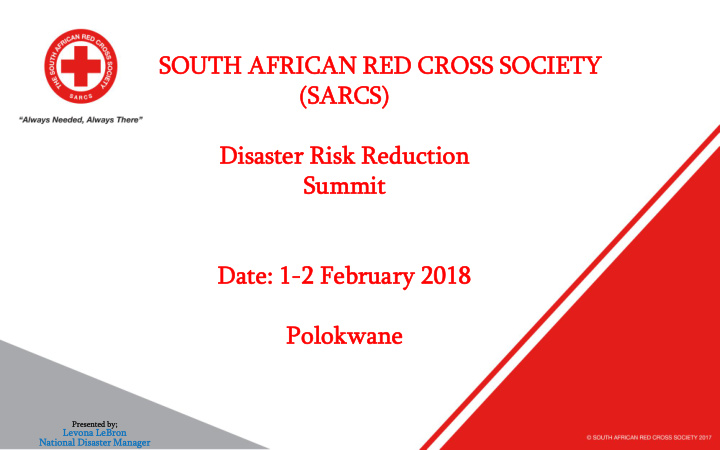



SOU OUTH TH AFR FRIC ICAN AN RED ED CROS OSS S SOC OCIE IETY TY (SARCS) RCS) Disaste ster r Risk Red eduction ction Summit mmit Date: e: 1-2 Feb ebrua uary ry 2018 8 Polokw okwane ane Prese sented ted by; Levona na LeBron on National onal Disas aster r Mana nager
OUR VISION To be a democratic service organization that is effective, high profile, dynamic and sensitive to the needs of all communities and acting within the fundamental principles of the Red Cross and Red Crescent Movement. OUR MISSION To render services, prevent and alleviate human suffering and to foster human dignity in all communities by addressing the basic needs of the people in accordance with the fundamental principles of the red cross red crescent movement.
Objectives The main objectives for which the Society is established are; a. Prevent and alleviate human suffering wherever it may be found. b. Protect life and health and ensure respect for the human being. c. To afford protection to those who need it in the event of armed conflict and other disasters like flood, fire, earthquakes. *This is to be done with complete impartiality *In support of Government NDP and interventions.
Membership society affiliation & responsibility • ICRC (Geneva) - coordinates international support for people affected by international armed conflict and internal strife. ICRC • Federation (IFRC Pretoria) - coordinates international support for non-conflict disaster affected people, assists NS with building their capacities. • National Societies (Sandton) - assist vulnerable people within their own territory and coordinates support according to capacity.
Pyramid of Principles How 1 . Humanity 2. Impartiality Means 3. Neutrality 4. Independence Method 5. Voluntary Service 6. Unity 7. Universality
Strategy 2020 Strategic Aim 2 Strategic Aim 3 Strategic Aim 1 Enable healthy and safe living Promote social Save lives, protect inclusion and a “ Contributing to livelihoods, and culture of non- combating HIV and strengthen recovery violence and peace. decreasing the burden of from disasters and TB amongst communities crises. and individuals in South Africa ”. Enabling Action 2 NCD: Enabling Action 3 Pursue and execute our humanitarian Function effectively, efficiently mandate to prevent and reduce and diligently as the society. vulnerabilities in communities. Enabling Action 1 Build strong Branches and National Society
Programmes Health and Care: HIV, TB - MDR TB, Non Communicable Disease Training: First Aid, OHS, Home Bases Care Disaster Management and Risk Reduction. Improve and increase resilience amongst vulnerable communities by DRR and training. Developing and strengthening institutions, mechanisms and capacities to build resilience to hazards. Systematic incorporation of risk reduction approaches into the implementation of emergency preparedness, response and recovery programmes. Humanitarian Values and Sustainable Livelihoods. Youth Peer and Young woman in development
DISASTER MANAGEMENT Disaster preparedness and relief and recovery (DPRR) a. Disaster Relief Capacity at community level. b. Emergency Preparedness, Relief and post recovery and rehabilitation. c. Linkages with District Municipalities, Tribal Authorities, Leadership Training a. Communities b. Volunteers Relief - Blankets, non perishable foods and clothing Tracing a. Restoring of Family Links. b. Work with NDMC, PDMC, LDC, Communities
Disaster Cycle
Local Economic Development on Community in times of Disaster Integrated approach: Sustainable livelihoods focusing on health, welfare of infants, children, girls and income generating activities. Mainstream Community: Based DRR to Local Economic Development. Align infrastructure development to DRR. Resilience: Resolve around lack of investment appetite in community-based interventions that strengthen community resilience.
Mainstreaming DRR into Developmental Planning DRR should be the core of service delivery in any particular Local Economic Development. Community and Local Government structures / institutions MUST champion DRR / prioritise education and training. Use existing public initiatives, like, EPWP, CWP, DSD to strengthen DRR Build community-based DRR teams and align them to solidarity/social economy projects. Local Government to partner with the civil society organisation on socio-economic programmes with DRR objectives.
Relief to Recovery Recovery / Rehabilitation Development Relief Continuum Model Recovery / Rehabilitation Development / Relief Continuum Model
Collaborative Way Forward (1) Prioritise constructive dialogue between Local Government and Civil Society Invest in programme-driven partnerships Prioritize Asset-Based Community Development (ABCD) programming that produce sustainable livelihoods, resilience and social cohesion – that empower communities to withstand shocks and adversity Work with financial institutions to develop insurance products for unbanked populations Promote Saving Groups/Stokvels in community as training platform for co- operatives including financial services co-operatives
Collaborative Way Forward (2) The South African Red Cross Society alone has more than 5 000 volunteers on stipend to take DRR to the next level through Asset-Based Community Development (ABCD) which prioritises; Community training (preparedness, prevention, mitigation, response and recovery). Food and nutrition security implementation. Promotion of disaster responsive financial services. Health promotion and improving of incomes of households.
National level Governance Management Intermediate level Communicate needs Representation Local Community level Volunteer committees / groups Assistance V V V V V V
SARCS BRANCHES
Capacity overview 35 branches 500 staff members 2200 active HBC/Peer volunteers looking after 60,000 regular clients and 40,000 OVC. 200 elderly and approximately 20,000 people affected by disasters incidents. Accessibility of SARCS trained volunteers in various communities. Sustainable branches / projects dependent and ECD Centres Other Programmes.
Characteristics of a Well-Functioning Society Adequately resourced in terms of personnel, infrastructure, supplies and logistics. Suitably qualified volunteers and staff to carry out services targeting the most vulnerable. Sustainable funding for projects and core costs, focus on local funding. Good External Relations/ Resource Mobilisation project Strong governance and management.
Disaster relief in action
Thank you
Recommend
More recommend